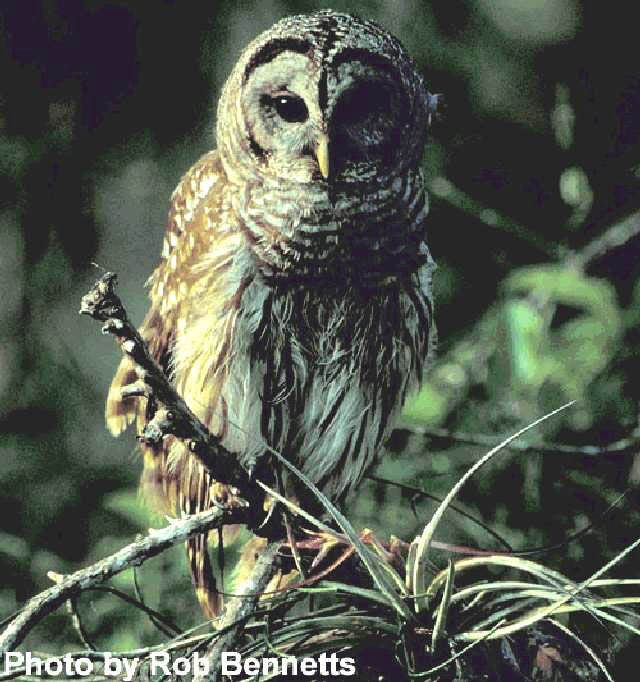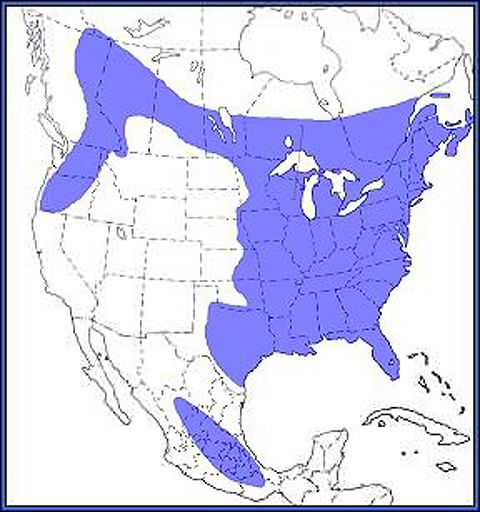Have you ever been walking in a forest and heard something that sounded like a very loud, piercing scream? Well, it's very likely that you've heard the call of the Barred Owl. The vocalization of this owl sounds like a powerful voice that says "Who cooks for you? Who cooks for you all?"
Across the eastern half of the United States, the Barred Owl makes its home in mature trees of woodlands and swamps. Related to the Spotted Owl and the Great Horned Owl, the Barred Owl is in the order Strigiformes and the subfamily Striginae. Owls in this group have a rounded facial disk and large ear openings.
Identification
These birds of prey are relatively large in size. The length of the bird is about 1-½ to 2 feet, and weights are about 22 oz. for males and 28 oz. for females. Wingspan is from 40–50 inches and body length ranges from 17–24 inches. The Barred Owl is named for the feather patterns, which are barred with the alternating colors of white and brown, located on its head, chest and back (Figure 1). The belly is streaked lengthwise with white and brown feathers. The eyes are big and dark brown and look black in the field. With a yellow bill, the face of a Barred Owl has a pale gray disc around each of the eyes. These discs are outlined with a dark brown line. Just behind the facial disc, the white and brown barred pattern begins and continues all the way down the bird's back.

Credit: Rob Bennetts, courtesy of USGS Patuxent Wildlife Research Center website at http://www.mbr-pwrc.usgs.gov/id/framlst/i3680id.html
Habitat
These owls tend to favor dense forests with large trees for nesting. Typically, Barred Owls are found in mature forest with a relatively open understory. An open understory in the forest is necessary so that they can perch on branches and be able to see, as well as fly, to catch their prey. The availability of perch sites has been found to be an important factor in habitat selection. The most important factor in selection of a breeding territory appears to be the amount of large trees, usually with trunk diameters larger than 20 inches. The Barred Owl can live in a variety of habitats. As long as the habitat contains an adequate amount of large trees for nesting, Barred Owls can live in urban areas, swamps, oak savannas, marshes, and forests located next to fields that provide prey animals.
Range
Barred Owls have a wide range within the United States and North America (Figure 2). In recent years, the species has begun to expand its range into the northern and western regions of the United States. The range of Barred Owls now extends into Canada and Mexico as well.

Credit: Dan Lockshaw, http://owling.com
Individual home ranges of the Barred Owl can be quite varied. The home range is the area in which an individual bird normally roams. In Michigan, annual home ranges of Barred Owls average about 1 square mile. An important factor involved in determining the size of an owl's home range is the season of the year. In the winter, when prey is less available, the owls use a larger range in order to find adequate food. However, when breeding, the home range is much smaller than at other times of the year.
Social Aspect
The Barred Owl is a resident species. Therefore, it does not migrate. Although many species of owls are strictly nocturnal, the Barred Owl is sometimes active during the day. The life span of these owls has been known to exceed 10 years in the wild. Captive birds have been known to live as long as 23 years.
The vocalizations of the Barred Owl have been used to identify the species in the forest. Males use two different calls. One call sounds like a deep barking call in which the bird will increase the volume of the call, and then end it with a powerful hoot. This call is believed to be a signal of aggression by the owl. The second call is used by the owl to state its territory and to attract mates. This call has a more rhythmic sound or pattern, much like the phrase "Who cooks for you, who cooks for you all?"
Diet and Hunting
Most of the hunting of the Barred Owl is nocturnal, which means that they hunt at night; however, they have been known to hunt during the day as well. Barred Owls often use habitat at the edge of a forest, such as open fields or meadows. In addition, they hunt in the open understory within a forest. Barred Owls usually perch on a branch or limb while seeking prey. One of the observed behaviors of the Barred Owl is the bobbing of their head while watching their prey. The bobbing motion is a vertical movement of the owl's head in an up and down manner, which aids it in determining the distance of the prey.
The most widely eaten prey are small mammals, such as short-tailed shrews, white-footed mice, rats and voles. In Maryland, these mammals constituted 66% of the owls diet, whereas birds accounted for 15% and arthropods, such as insects, 20% of their diet. In Mississippi, the Barred Owl consumes crayfish in greater abundance than small mammals. This array of prey items illustrates the adaptability of the species to live on whatever food source is available. If the prey is small enough, the bird may swallow it whole. If they swallow it whole, the owls will later regurgitate pellets consisting of the indigestible parts, such as bones and fur.
Reproduction
In Florida, the Barred Owl normally breeds from late January to March. The average clutch of the Barred Owl is 2 to 4 eggs. The owls will locate their nests in mature trees, snags, and even old hawk nests. Incubation of the eggs takes from 28 to 33 days. During the time the female incubates the eggs, the male brings food to her. At 4 weeks of age, the nestling owls begin to perch on branches near the nest, but still get food from their parents. By the age of 6 weeks, the nestlings are independent. Although not much is known about Barred Owl nesting, it is known that if the eggs are destroyed, the pair will nest again about 3 to 4 weeks later.
Most of the trees Barred Owls use for nesting in the southeastern United States are deciduous trees. Deciduous trees lose their leaves in the fall. However, in the northern and northwestern United States, Barred Owls also nest in mature conifers. Conifers are trees that do not loose their leaves, such as pines. Barred Owl nests are usually situated in cavities in naturally hollowed trees and snags (dead trees). Sometimes old nests of hawks, crows, and squirrels are used by Barred Owls. Whenever possible, the owls will usually occupy the same nest site every year.
Conservation Efforts
The Barred Owl is in need of mature trees for nesting if it is to maintain stable population levels. For the conservation of the species, it is important to protect and manage the older trees in the upland woods and wetland areas. Open understories, which usually occur in mature forests, are important for owls to be able to hunt animals on the forest floor. However, Barred Owls may also hunt in other areas such as open fields next to a forest. Therefore, management plans that maintain both open fields and forests are important for the conservation of the species.
References
Johnsgard, Paul A. (1998). North American Owls: Biology and Natural History. Washington, D.C.: Smithsonian Institution Press.
Kale, Herbert W., II, David S. Maehr, and Karl Karalus (Illustrator). (1990). Florida's Birds. Sarasota Florida: Pineapple Press.
Konig, Claus, Friedhelm, Weick, and Becking, Jan-Henderik (1991). Owls: A Guide to the Owls of the World. London: Yale University Press.
Simbeck, Rob (1997). "For Wildlife Watchers: Barred Owl". South Carolina Wildlife, 42-43.
Stevenson, Henry M., and Anderson, B.H. (1994). Birdlife of Florida. Gainesville, Florida: University Press of Florida.
Credits
Photograph obtained from the United States Geological Survey (USGS) Patuxent Wildlife Research Center Website (see reference below), and used with permission of photographer Rob Bennetts.
Gough, G.A., Sauer, J.R., Iliff, M. Patuxent Bird Identification Infocenter. 1998. Version 97.1. Patuxent Wildlife Research Center, Laurel, MD.
Range map obtained from Owling.com, and used with permission of Dan Lockshaw.